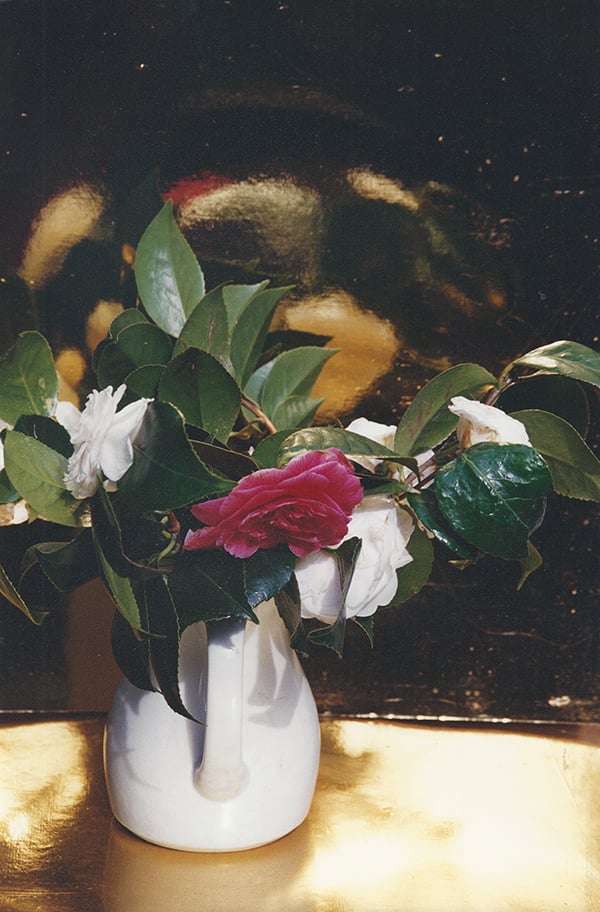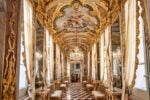Marilú Eustachio – Heimat 2

Mostra personale.
Comunicato stampa
„Marilù Eustachio (1934 in Meran geboren, lebt in Rom) verbindet mit dem Vinschgau bis heute das Gefühl von Heimat. In den vergangenen Jahren hat sie sich dieser Heimat in rund 70 Blättern angenähert. Eine Auswahl der gleichnamigen Serie wurde bei Kunst Meran gezeigt. Neben dem Zyklus „Heimat“ wurde auch eine Auswahl von Arbeiten aus den vergangenen zwanzig Jahren als Einblick in das umfassende Schaffen Eustachios gezeigt.“ Das schrieb die Kuratorin der Ausstellung und künstlerische Leiterin von Kunst Meran in der Einladung zur Ausstellung. Nachdem ich die Arbeit von Marilù Eustachio seit Jahren verfolge und ihren künstlerischen Werdegang begleitet habe, solange ich die Galerie Spatia in Bozen führte, war ich Kunst Meran und Frau Rekade sehr dankbar, dass Meran eine Künstlerin ehrte, die in Meran geboren wurde. Eine verdiente und auch fällige Hommage ihrer Geburtsstadt. 2016, quasi zu ihrem 80. Geburtstag, hat das Museion in der Studiensammlung eine von Andreas Hapkemeyer kuratierte Auswahl ihrer „Taccuini“ vorgestellt. Nun wird mit einer Fotoausstellung in der Galerie Fotoforum der Heimatzyklus mit einer Auswahl von Fotografien, die alle Südtirol gewidmet sind, abgeschlossen.
Marilù Eustachio ist eine ganz besondere Persönlichkeit. Sie kommt aus Rom. Sie spricht römisch und denkt römisch, bewegt sich in einem römischen Freundeskreis und Ambiente, aber ihre Besonderheit besteht darin, dass sie sich als Tiroler-Römerin fühlt. Nicht nur weil sie in Meran geboren wurde, sie hat auch Jahre ihrer Kindheit im Vinschgau verbracht, ihre Mutter kam aus Malls, und sie ist bis vor kurzem noch jedes Jahr für längere Zeit nach Südtirol, nach Ums bei Völs, gekommen. Und ihre Südtirol-Begeisterung war so groß, dass sie zahlreiche römische Künstler und Intellektuelle überzeugt hat, in Südtirol Urlaub zu machen, „la terra piú bella“. Und deshalb hatten der Titel der Ausstellung, „Heimat“, und nun die Fotoserie „Heimat 2“ nichts Kitschiges oder gar Patriotisches in sich, nein, die Heimat ist Eustachio eine Herzensangelegenheit, eine innige Verbundenheit, eine Sache des Gefühls.
Und die Landschaften Südtirols haben auch zahllose Werke der Künstlerin inspiriert, sie hat sicherlich Tausende Zeichnungen und Fotografien angefertigt, die alle in die Werkmappe „Tirolo“ gehören. Weniger bekannt sind ihre Fotoarbeiten, auch wenn sie viele Jahre immer sowohl mit dem Skizzenbuch und dem Fotoapparat unterwegs war, mit dem sie Impressionen festhielt, Ausschnitte von Häusern, Landschaften, Friedhöfen und auch Menschen. Viele ihrer Fotoarbeiten sind Stillleben. Zufallsgegenstände, als Stillleben arrangiert. Es sind Berge, Bäume, Blumen und Landschaften, die sich nach und nach aus unbegrenzten Zeichen entwickeln, die sich aneinanderreihen und sich gegenseitig auflösen. Wie in ihren Zeichnungen mit minimaler Grafik Formen wachsen, so zeigen ihre Fotoarbeiten die Körperlichkeit des Objekts und die Strukturen der Landschaft in ihrer sichtbaren Immaterialität. Eustachio hüllt ihre Landschaften in einen atmosphärischen Schleier und löst so den Gegenstand von den Eigenschaften des Gewichts und der Dichte. Das Erfassen der atmosphärischen Stimmung und die Wiedergabe des subjektiven Eindrucks bestimmen die stilistischen Wesenszüge ihrer Arbeit.
Mit dem mal mehr mal minder dichten „atmosphärischen“ Schleier, in die sie ihre Landschaften hüllt, verfolgt die Künstlerin die Beseelung des Sujets, eine poetische Verklärung. So entstehen Landschaften mit arkadischen Anmutungen. Es gelingt ihr, Momente zu fixieren, wo das Zufällige sich zur ausbalancierten Komposition verdichtet: romantisch, symbolisch, lyrisch, malerisch.
(Arnold Tribus)
„Meine ersten sensoriell-kognitiven Erfahrungen sind für mich an Südtirol gebunden: harmonisches Plätschern von Bächlein, das ungestüme Rauschen der Wildbäche, Winde in Bäumen, Regen auf Schindeldächern, Düngergeruch in den Gärten, Geruch eben gemähten Grases, des Harzes und des Holzes“, schreibt die Künstlerin über sich.
it
«Marilù Eustachio (nata a Merano nel1934, vive a Roma) ancora oggi associa la Val Venosta al sentimento di patria. Negli ultimi anni si è accostata a questa sua patria attraverso circa 70 opere: una scelta della serie „Heimat“ è stata presentata alla Kunst Meran/Merano Arte, dove, oltre a questo ciclo, è stata esposta una selezione di lavori degli ultimi vent'anni, offrendo così un’ampia prospettiva sulla vasta opera di Eustachio». Con queste parole la curatrice della mostra e direttrice artistica del Kunst Meran introduceva l’esposizione. Dopo aver seguito il lavoro di Marilú Eustachio per anni e dopo aver accompagnato la sua carriera artistica lungo tutto il periodo della mia gestione della Galleria Spatia a Bolzano, sono molto grato alla Kunst Meran e alla signora Rekade per aver onorato un’artista nata a Merano. È un meritato e dovuto omaggio alla sua città natale. Nel 2016, in occasione del suo imminente ottantesimo compleanno, il Museion ha presentato, all’interno della collezione di studi, una scelta dei suoi "Taccuini" curata da Andreas Hapkemeyer. Ora si completa il ciclo sulla Heimat grazie a una mostra fotografica nella galleria Fotoforum, con una selezione di fotografie tutte dedicate all'Alto Adige.
Marilú Eustachio è una personalità molto speciale. Lei è di Roma, parla romano e pensa romano, si muove in una cerchia di amicizie romane e nel suo ambiente ma, questa la sua particolarità, si sente una tirolese-romana. Non solo perché è nata a Merano, ma anche perché ha trascorso gli anni della sua infanzia in Val Venosta (sua madre veniva da Malles Venosta) e fino a poco tempo fa tornava ogni anno per lunghi periodi in Alto Adige a Umes, vicino a Fiè allo Sciliar. Il suo entusiasmo per l'Alto Adige è stato così intenso da spingerla a convincere numerosi artisti e intellettuali romani a trascorrere le loro vacanze in Alto Adige, “la terra più bella”. Ecco perché il titolo della mostra „Heimat“ – e ora la serie di fotografie „Heimat 2“ – non ha nulla in sé di kitsch o ancor meno di patriottico: la patria per Eustachio è una questione di cuore, implica un legame intimo, è un vero e proprio sentimento.
I paesaggi dell'Alto Adige hanno ispirato innumerevoli opere dell'artista, la quale ha senz’altro realizzato migliaia di disegni e di fotografie, tutti appartenenti alla raccolta di opere "Tirolo". Meno noti sono i suoi lavori fotografici, anche se lei, per molti anni, ha sempre viaggiato con il quaderno da disegno e con la macchina fotografica, catturando con quest’ultima impressioni, dettagli di case, paesaggi, cimiteri e persone. Molte delle sue fotografie sono nature morte, oggetti casuali disposti come nature morte. Vediamo montagne, alberi, fiori e paesaggi svilupparsi gradualmente da segni molteplici che si susseguono e si dissolvono l’uno nell’altro. Allo stesso modo in cui nei suoi disegni vengono a crearsi forme di grafica minimale, le sue fotografie mostrano la fisicità dell'oggetto e svelano le strutture del paesaggio nella sua visibile immaterialità. Eustachio avvolge i suoi paesaggi in un velo atmosferico, liberando così l'oggetto dalle proprietà di peso e di densità. La percezione di una condizione atmosferica e la resa dell'impressione soggettiva determinano i tratti stilistici del suo lavoro.
Con il velo "atmosferico" – a volte più, a volte meno denso – di cui circonda i suoi paesaggi, l'artista persegue l’animazione del sujet, una trasfigurazione poetica. Scaturiscono così paesaggi di apparenze arcadiche. Riesce a fissare istanti in cui il casuale si condensa in una composizione equilibrata: romantica, simbolica, lirica, pittorica.
(Arnold Tribus)
«Le mie prime esperienze sensoriali-cognitive sono legate all'Alto Adige: i gorgoglii armonici dei corsi d'acqua, lo scrosciare impetuoso dei torrenti, i venti fra gli alberi, la pioggia sulle scandole, l'odore di concime nei giardini, il profumo dell’erba appena falciata, quello della resina e del legno», scrive l’artista di se stessa.
en
“Marilù Eustachio (born in Merano in 1934, living in Rome) associates the Vinschgau region with her feeling of home to this very day. In the past few years, she has got closer to this home in circa 70 folios. A selection from the series of the same name was shown at Kunst Meran/Merano Arte. In addition to the “Heimat” cycle, a selection of works from the past twenty years was also shown, a glimpse into Eustachio’s extensive creative oeuvre.” That is what the curator of the exhibition and artistic director of Kunst Meran wrote in her invitation to the exhibition. Having followed the work of Marilù Eustachio for years, accompanying her artistic development as long as I managed the Galerie Spatia in Bolzano, I was very grateful to Kunst Meran and Ms. Rekade that Merano honoured an artist born in Merano. A merited—and overdue—homage to her birthplace. In 2016, for her 80th birthday as it were, the Museion presented in its Study Collection a selection of her “Taccuini” curated by Andreas Hapkemeyer. Now, a photo exhibition in the Fotoforum gallery concludes the “Home” cycle with a selection of photographs, all of which are dedicated to South Tyrol.
Marilù Eustachio is a unique personality. She comes from Rome. She speaks Roman and thinks Roman, she moves in a Roman circle of friends and ambiance, but, idiosyncratically enough, she feels like a Tyrolean Roman. Not just because she was born in Merano: she spent years of her childhood in the Vinschgau region, her mother came from Malls, and until quite recently she came every year to South Tyrol, to Ums bei Völs. And her enthusiasm for South Tyrol was such that she persuaded numerous Roman artists and intellectuals to take their holidays in South Tyrol, “la terra piú bella”. That’s why there’s nothing kitschy or even patriotic about the title “Heimat” of the exhibition and now the photo series “Heimat 2”. No, for Eustachio, home is a matter close to her heart, a heartfelt connection, a matter of feeling.
And South Tyrol’s landscapes have also inspired countless works by the artist; she has undoubtedly produced thousands of drawings and photographs which all make up part of the “Tirolo” portfolio. Her photographic works are less well-known, though for many years she was always out and about with both sketchbook and camera, with which she captured impressions, details of houses, landscapes, cemeteries, as well as people. Many of her photographic works are still lifes. Random objects, arranged as still lifes. They are mountains, trees, flowers and landscapes that gradually emerge from indefinite signs that are strung together and break each other apart. Just as forms grow in her drawings with minimal graphics, her photographic works show the physicality of the object and the structures of the landscape in its visible immateriality. Eustachio shrouds her landscapes in an atmospheric haze, thus releasing the object from the properties of weight and density. Capturing the atmospheric mood and rendering the subjective impression constitute the stylistic characteristics of her work.
With the—more or less—dense “atmospheric” haze in which she shrouds her landscapes, the artist pursues the soul of the subject, a poetic transformation. In this way, landscapes arise with Arcadian impressions. She succeeds in freezing moments where the incidental consolidates to a balanced composition: romantic, symbolic, lyrical, pictorial.
(Arnold Tribus)
“For me, my first sensory and cognitive experiences are linked with South Tyrol: harmonious murmuring of little streams, the fierce roaring of torrents, wind in trees, rain on shingle roofs, the smell of manure in the gardens, the smell of freshly mown grass, of resin and of wood,” the artist writes about herself.



